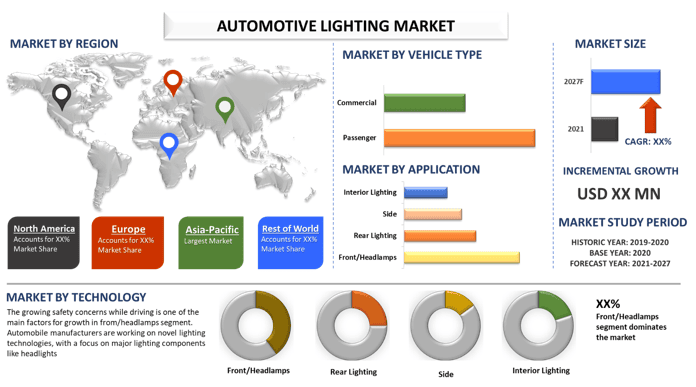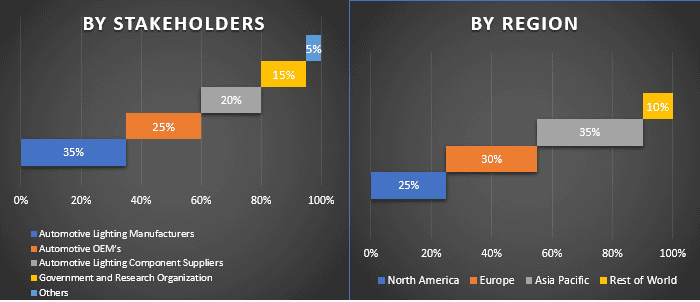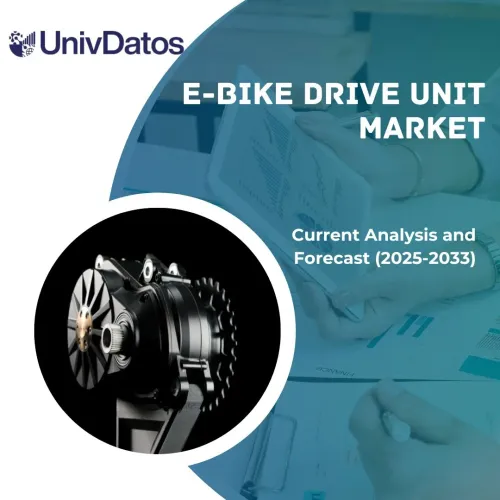- Home
- About Us
- Industry
- Services
- Reading
- Contact Us
Automotive Lighting Market: Current Analysis and Forecast (2021-2027)
Emphasis on Vehicle Type (Passenger Car and Commercial Vehicle); Technology (Halogen, Xenon, LED and Other); Application (Front/Headlamps, Rear Lighting, Side, and Interior Lighting); Sales Channel (OEMs and Aftersales); Region and Country

Global Automotive Lighting Market is anticipated display a CAGR of around ~11% over the forecast period (2021-2027). The demand for automobiles with modern technologies has increased as vehicle manufacturing and sales have increased around the world. As a result, automakers are developing and installing cutting-edge components in next car models. Companies such as Hella KGAA HUECK & Co., for example, are developing and introducing new lighting systems with various functions such as connecting with pedestrians to ensure safety and suit client expectations. Automobile sales are rapidly increasing in developing countries such as Brazil, Russia, India, and China (BRIC). Furthermore, factors such as urban population growth, rising income levels, and changing lifestyles all contribute to the growth of the automotive lighting industry.
Insights Presented in the Report
“Amongst Vehicle Type, Passenger Car segment dominated the market in 2020”
Based on vehicle type, the market is segmented into Passenger Car and Commercial Vehicle. The Passenger Car segment is expected to grow at a higher rate during the forecasted period. Due to rising disposable income and the evolving lifestyle of the urban population, demand for passenger vehicles is rapidly expanding. The most essential component of the development in passenger cars is that people’s thinking has shifted from vehicles as a luxury to vehicles as a necessity. Furthermore, the automobile rental industry’s expanding economic prospects are driving passenger car takeovers. Passenger automobiles are the most common means of transportation in industrialized countries, and their use is growing in underdeveloped countries as per capita income rises.
“Amongst Technology, LED segment dominated the market in 2020.”
Based on technology, the market is segmented into Halogen, Xenon, LED and Other. The LED segment is expected to grow at a higher rate during the forecasted period. During the projected period, LED is expected to increase at the fastest rate. This could be due to a shift in light control technology that is more energy efficient. LED headlights have a wide range of capabilities and versatility, making them ideal for use in a variety of vehicle lighting applications. LED lights are commonly fitted in high-end automobiles due to their multiple advantages, including low power consumption, increased adaptability, and great aesthetic value. Furthermore, when compared to xenon lights, LED headlights have a lower impact on the driver on the opposite side, and as a result, this technology is generally recognized in the market. The segment’s expansion is likely to be fueled by a rising number of newly manufactured automobiles equipped with LED lighting systems.
“Amongst Application, BEV segment dominated the market in 2020.”
Based on application, the market is segmented in Front/Headlamps, Rear Lighting, Side and Interior Lighting. The Front/Headlamps segment is expected to grow at a higher rate during the forecasted period. The growing safety concerns while driving is one of the main factors for this growth. Automobile manufacturers are working on novel lighting technologies, with a focus on major lighting components like headlights. They are forming partnerships in order to stay ahead of the competition in the industry. Headlights are an important part of creating a safe driving environment at night. Volkswagen, for example, collaborated with Hella to produce IQ.LIGHT LED headlamps.
“Amongst Sales Channel, Aftersales segment dominated the market in 2020.”
Based on sales channel, the market is segmented in OEMs and Aftermarket. The automotive aftermarket consists of the replacement of halogen lights with LEDs in newly purchased vehicles and lights that are damaged. The demand for replacement of halogen lights mainly exists in developed countries
“Asia Pacific represents as the largest market.”
For a better understanding of the market adoption of Automotive Lighting, the market is analyzed based on its worldwide presence in the countries such as North America (United States, Canada, Rest of North America), Europe (Germany, UK, France, Italy, Rest of Europe), Asia-Pacific (China, Japan, India, South Korea, Rest of APAC), and Rest of World. During the projection period of 2021-2027, Asia Pacific is expected to be the largest market. Due to the presence of developing economies such as India, China, and a few other South-East Asian countries, Asia-Pacific is the fastest-growing region. In the future years, the market will be dominated by technical innovation and an emphasis on government regulations. Due to its dominant position in automotive production, Asia-Pacific has the highest adoption rate. Increased sales of new automobiles, as well as a focus on automotive lighting research and development, are likely to drive the market for automotive lighting in Asia-Pacific. The sale of passenger cars and commercial vehicles is directly influenced by the area’s economic progress. Furthermore, manufacturers in these countries place a high priority on technology improvements, which includes lighting, resulting in increased demand for vehicle lighting. The market would be pushed even further by rising consumer per capita income and strong SUV sales in emerging markets like India. Some of the major players operating in the market includes Koito Manufacturing Co. Ltd., Hella KGaA Hueck & Co., Osram Licht AG, Robert Bosch GmbH, Stanley Electric Co. Ltd., Valeo, Zizala Lichtsysteme GmbH, Koninklijke Philips N.V., Hyundai Mobis and DENSO Corporation etc.
Reasons to buy this report:
- The study includes market sizing and forecasting analysis validated by authenticated key industry experts
- The report presents a quick review of overall industry performance at one glance
- The report covers an in-depth analysis of prominent industry peers with a primary focus on key business financials, product portfolio, expansion strategies, and recent developments
- Detailed examination of drivers, restraints, key trends, and opportunities prevailing in the industry
- The study comprehensively covers the market across different segments
- Deep dive regional & country-level analysis of the industry
Customization Options:
The Global Automotive Lighting Market can further be customized as per the requirement or any other market segment. Besides this, UMI understands that you may have your own business needs, hence feel free to connect with us to get a report that completely suits your requirements.
Table of Content
Lighting is an essential component of automobiles and plays a critical role in vehicle safety. Road accidents kill over 1.35 million people each year, according to the Association for Safe International Road Travel. Furthermore, every year, 20-50 million individuals are injured or crippled as a result of traffic accidents or natural weather conditions such as rain, fog, dust, snow, and other factors. These figures demonstrate the importance of efficient illumination in automobiles in order to avoid catastrophic accidents, and this is a critical component for manual driving. Various governments are taking steps to raise awareness about the need of driving safely, and one of the major components that must be considered while driving is automotive lighting. In today’s automobiles, a wide range of lighting is available, including headlights, taillights, accessory lights, LED lights, fog lights, emergency and warning lights, off-road lights, and signal lights.
Analysis of Historical Market Size
Step 1: In-Depth Study of Secondary Sources:
Detailed secondary study was conducted to obtain the historical market size of the Automotive Lighting Market through company internal sources such as annual report & financial statements, performance presentations, press releases, etc., and external sources including journals, news & articles, government publications, competitor publications, sector reports, third-party database, and other credible publications.
Step 2: Market Segmentation:
After obtaining the historical market size of the Automotive Lighting, we conducted a detailed secondary analysis to gather historical market insights and share for different segments & sub-segments for major regions. Major segments included in the report are by vehicle type, technology, application, and sales channel. Further regional & country-level analyses were conducted to evaluate the overall adoption of the Automotive Lighting Market in the global context.
Step 3: Factor Analysis:
After acquiring the historical market size of different segments and sub-segments, we conducted a detailed factor analysis to estimate the current market size. Further, we conducted factor analysis using dependent and independent variables such as growing government incentives and demand for eco-friendly transportations etc. Historical trends and their year-on-year impact on the market size and share was analyzed. Demand and supply side scenario was also thoroughly studied.
Current Market Size Estimate & Forecast
Current Market Sizing: Based on actionable insights from the above 3 steps, we arrived at the current market size, key players in the Market, and market shares of the segments and company. All the required percentage split, and market breakdowns were determined using the above-mentioned secondary approach and were verified through primary interviews.
Estimation & Forecasting: For market estimation and forecast, weights were assigned to different factors including drivers & trends, restraints, and opportunities available for the stakeholders. After analyzing these factors, relevant forecasting techniques i.e., bottom-up approach was applied to arrive at the market forecast to 2027 for different segments and subsegments across the major regions globally. The research methodology adopted to estimate the market size encompasses:
- The industry’s market size, in terms of value (US$) and the adoption rate of Automotive Lighting across the major markets
- All percentage shares, splits, and breakdowns of market segments and sub-segments
- Key players in the Automotive Lighting Market in terms of products offered. Also, the growth strategies adopted by these players to compete in the fast-growing market.
Market Size and Share Validation
Primary Research: In-depth interviews were conducted with the Key Opinion Leaders (KOLs) including Top Level Executives (CXO/VPs, Sales Head, Marketing Head, Operational Head, and Regional Head, Country Head, etc.) across major countries. Primary research findings were then summarized, and statistical analysis was performed to prove the stated hypothesis. Inputs from primary research were consolidated with secondary findings, hence turning information into actionable insights.
Split of Primary Participants in Different Regions

Market Engineering
Data triangulation technique was employed to complete the overall market estimation and to arrive at precise statistical numbers of each segment and sub-segment of the Automotive Lighting market. Data was split into several segments & sub-segments post studying various parameters and trends in the areas of mode, battery type, application, and region.
The main objective of the Automotive Lighting Market Study
The current & future market trends of Automotive Lighting were pinpointed in the study. Investors can gain strategic insights to base their discretion for investments from the qualitative and quantitative analysis performed in the study. Current and future market trends would determine the overall attractiveness of the market at a regional & country level, providing a platform for the industrial participant to exploit the untapped market to benefit as a first-mover advantage. Other quantitative goals of the studies include:
- Analyze the current and forecast market size of Automotive Lighting in terms of value (US$). Also, analyze the current and forecast market size of different segments and sub-segments
- Segments in the study include type, application, and vehicle
- Defined analysis of the regulatory framework for the Global Automotive Lighting industry
- Analyze the value chain involved with the presence of various intermediaries, along with analyzing customer and competitor behaviors of the industry
- Analyze the current and forecast market size of the Automotive Lighting for the major regions & countries
- Major regions studied in the report include North America (US, Canada, Rest of North America), Europe (Germany, United Kingdom, France, Italy, Rest of Europe), Asia Pacific (China, Japan, India, South Korea, Rest of Asia-Pacific), and Rest of World
- Company profiles of the Automotive Lighting Market players and the growth strategies adopted by them to sustain in the fast-growing market
- Deep dive regional & country level analysis of the industry
Related Reports
Customers who bought this item also bought










